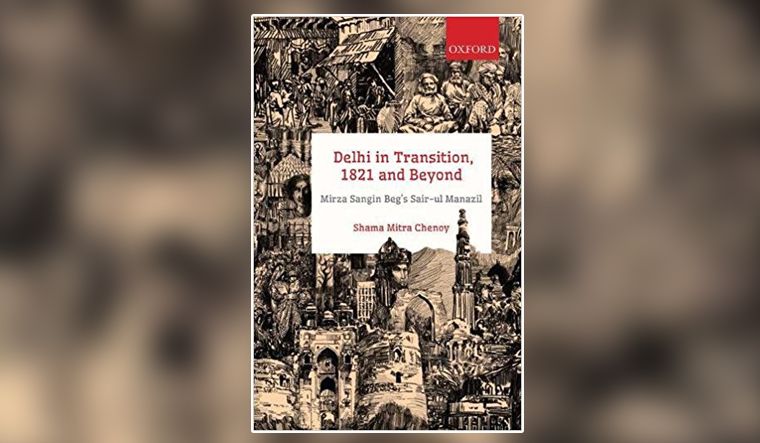The official website of the Delhi government says there have been seven cities of Delhi—Qila Rai Pithora, Mehrauli, Siri, Tughlaqabad, Firozabad, Shergarh and Shahjahanabad. The list misses many, including New Delhi which was completed only in 1929, and from where India is ruled.
This book, which was originally written in 1821—perhaps the first modern guidebook to Delhi's monuments—gives several more. There were Lal Kot of the Tomaras who were the first dynasty to rule from Delhi, Qila Rai Pithora of the Chauhans, Qutbuddin's Mahrauli (around the Qutab complex), Balban's Merzghan, Muizzuddin's Kilokheri, Jalaluddin Khilji's Kushk-i Lal, Alauddin's Siri, Ghiyasuddin's Tughlaqabad, Muhammad bin's Shahpura, Firoze Shah's Ferozabad or Firoze Shah Kotla, Khizr Khan's Khizrabad, the unknown Mubarakabad, Humayun's Dinpanah which Sher Shah rebuilt as Shergarh, Salim Shah's Salimgarh, and Shajehan's Shajehanabad
(To the list, this reviewer would add two more. One, the Civil Lines which the British built during the time this book was originally written, and the modern New Delhi built a century after this book was written.)
The circumstances in which the original book (four manuscripts of which have been traced by the present author Shama Mitra Chenoy) was written were fascinating. At the dawn of the 19th century, the Marathas had captured most of north India and the Mughal emperor in Delhi was under their control. The British were expanding from Bengal westwards across the Gangetic plain. It was natural that the two powers had to clash. In 1803, Lord Gerald Lake defeated the combined Maratha-Mughal army in the famous battle of Patparganj, and captured Delhi.
Though they entered the city as conquerors, the British were simply overwhelmed by the city. There was the emperor (remember the phrase 'Great Mogul'), his gilded court, its courtesies and etiquette, a highly cultured populace, elegant palaces, haunted tombs, grand masjids, magnificent streets, rich libraries, scholars, fat nawabs, skilled tradesmen, priests and prostitutes.
Everything in Delhi fascinated them, and they didn't dare upset it. They let the emperor continue on the throne, of course under their supervision, and began to sink into the city and its culture. They set up a small township, which is now called the Civil Lines, north of the Red Fort and lived there, carefully guiding the destiny of the city, without upsetting the city's cultural milieu.
During the next half century (till the revolt of 1857), the British had several colourful men as residents, commissioners and senior civil and military officers in Delhi who became part of the city's folklore. The two legendary Metcalfes, Captain Macpherson, the great Gurkha war hero David Ochterlony who maintained a large harem of Hindu and Muslim wives, Col. James Skinner who built Delhi's oldest church which still stands in Delhi serenely—all walked through the streets of Delhi in that half century, wining, dining, whoring, ruling and extending patronage. If Ochterlony, Metcalfe and Skinner built several beautiful mansions (for themselves and their wives), Fraser and others undertook studies of the city, its culture and its history.
This book, rather its original, was commissioned by Fraser who wanted to compile the list of Delhi's monuments. The author, a Persian scholar by name Mirza Sangin Beg, walked through the city and recorded every major monument. (Interestingly, most of which still exist, though several of them have been encroached upon.) Not only did he give detailed descriptions of the monuments, but also recorded the inscriptions found on their walls. These inscriptions give out several unknown stories about the city.
The original book, titled Sair-ul Manazil and written in Persian, is a scholarly guidebook, perhaps the first, to Delhi's monuments. Subsequently several versions came to be there. The present author, Shama Mitra Chenoy who teaches History in Shivaji College, Delhi University, has painstaking searched out four manuscripts that have been lying in archives in Delhi, London and Berlin, and attempted a holistic translation. Wherever there are variations among the four texts, Chenoy has clearly indicated them. That makes the reading a little laboured, but then the book is meant as one of record, and not a free rendering of the old account.
Delhi in Transition, 1821 and Beyond: Mirza Sangin Beg's Sair-up Manazil
Edited by Shama Mitra Chenoy
Published by Oxford University Press
220 pages; Rs 995


